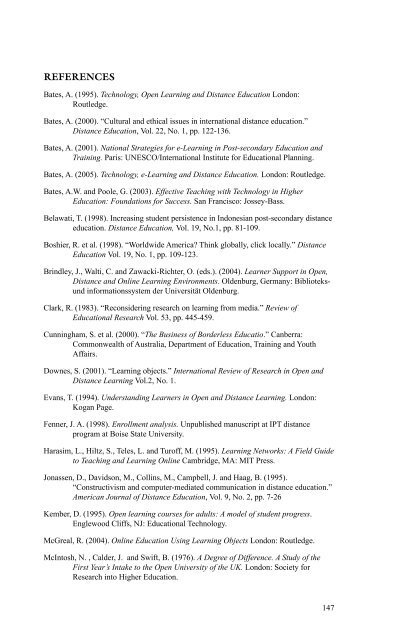lifelong learning and distance higher education - Asia Pacific Region
lifelong learning and distance higher education - Asia Pacific Region
lifelong learning and distance higher education - Asia Pacific Region
- No tags were found...
You also want an ePaper? Increase the reach of your titles
YUMPU automatically turns print PDFs into web optimized ePapers that Google loves.
REFERENCESBates, A. (1995). Technology, Open Learning <strong>and</strong> Distance Education London:Routledge.Bates, A. (2000). “Cultural <strong>and</strong> ethical issues in international <strong>distance</strong> <strong>education</strong>.”Distance Education, Vol. 22, No. 1, pp. 122-136.Bates, A. (2001). National Strategies for e-Learning in Post-secondary Education <strong>and</strong>Training. Paris: UNESCO/International Institute for Educational Planning.Bates, A. (2005). Technology, e-Learning <strong>and</strong> Distance Education. London: Routledge.Bates, A.W. <strong>and</strong> Poole, G. (2003). Effective Teaching with Technology in HigherEducation: Foundations for Success. San Francisco: Jossey-Bass.Belawati, T. (1998). Increasing student persistence in Indonesian post-secondary <strong>distance</strong><strong>education</strong>. Distance Education, Vol. 19, No.1, pp. 81-109.Boshier, R. et al. (1998). “Worldwide America? Think globally, click locally.” DistanceEducation Vol. 19, No. 1, pp. 109-123.Brindley, J., Walti, C. <strong>and</strong> Zawacki-Richter, O. (eds.). (2004). Learner Support in Open,Distance <strong>and</strong> Online Learning Environments. Oldenburg, Germany: Biblioteksundinformationssystem der Universität Oldenburg.Clark, R. (1983). “Reconsidering research on <strong>learning</strong> from media.” Review ofEducational Research Vol. 53, pp. 445-459.Cunningham, S. et al. (2000). “The Business of Borderless Educatio.” Canberra:Commonwealth of Australia, Department of Education, Training <strong>and</strong> YouthAffairs.Downes, S. (2001). “Learning objects.” International Review of Research in Open <strong>and</strong>Distance Learning Vol.2, No. 1.Evans, T. (1994). Underst<strong>and</strong>ing Learners in Open <strong>and</strong> Distance Learning. London:Kogan Page.Fenner, J. A. (1998). Enrollment analysis. Unpublished manuscript at IPT <strong>distance</strong>program at Boise State University.Harasim, L., Hiltz, S., Teles, L. <strong>and</strong> Turoff, M. (1995). Learning Networks: A Field Guideto Teaching <strong>and</strong> Learning Online Cambridge, MA: MIT Press.Jonassen, D., Davidson, M., Collins, M., Campbell, J. <strong>and</strong> Haag, B. (1995).“Constructivism <strong>and</strong> computer-mediated communication in <strong>distance</strong> <strong>education</strong>.”American Journal of Distance Education, Vol. 9, No. 2, pp. 7-26Kember, D. (1995). Open <strong>learning</strong> courses for adults: A model of student progress.Englewood Cliffs, NJ: Educational Technology.McGreal, R. (2004). Online Education Using Learning Objects London: Routledge.McIntosh, N. , Calder, J. <strong>and</strong> Swift, B. (1976). A Degree of Difference. A Study of theFirst Year’s Intake to the Open University of the UK. London: Society forResearch into Higher Education.147
















